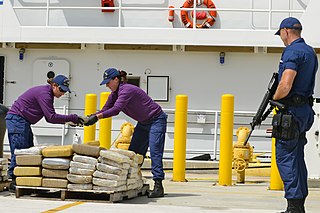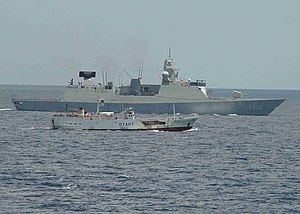
The United States Coast Guard (USCG) is the maritime security, search and rescue, and law enforcement service branch of the United States Armed Forces and one of the country's eight uniformed services. The service is a maritime, military, multi-mission service unique among the United States military branches for having a maritime law enforcement mission with jurisdiction in both domestic and international waters and a federal regulatory agency mission as part of its duties. It is the largest and most powerful coast guard in the world, rivaling the capabilities and size of most navies.

A coast guard or coastguard is a maritime security organization of a particular country. The term embraces wide range of responsibilities in different countries, from being a heavily armed military force with customs and security duties to being a volunteer organization tasked with search and rescue without law enforcement authority. In most countries, a typical coast guard's functions are distinct from those of the navy and the transit police, while in certain countries has similarities to both.

The Pakistan Coast Guards is a maritime law enforcement agency within the Civil Armed Forces of Pakistan. It is managed and controlled by the Pakistan Army, with a mission of riverine operations and coastal operations including conducting anti-narcotics missions, anti-human trafficking, illegal immigration through the coastal areas, and anti-smuggling initiatives.

USCGC Dallas (WHEC-716) was a United States Coast Guard high endurance cutter commissioned in 1967 at the Avondale Shipyard in New Orleans, Louisiana. She was the sixth ship or boat to bear the name of Alexander J. Dallas, the Secretary of the Treasury under President James Madison (1814–1816). She is one of twelve Hamilton-class cutters built for the Coast Guard.

Law Enforcement Detachments or LEDETs are specialized, deployable maritime law enforcement teams of the United States Coast Guard. First established in 1982, their primary mission is to deploy aboard U.S. and allied naval vessels to conduct and support maritime law enforcement, interdiction, or security operations. LEDETs are the operational elements of the Coast Guard’s two Tactical Law Enforcement Teams (TACLETs) which were part of the Coast Guard’s Deployable Operations Group (DOG) from 2007 to 2013. As of April 2010 there are seventeen LEDETs.
The United States Coast Guard is the coastal defense, search and rescue, and maritime law enforcement branch of the United States Armed Forces and is one of the country's eight uniformed services. It carries out three basic roles, which are further subdivided into eleven statutory missions. The three roles are:

Vietnam Coast Guard (VCG, Vietnamese: Cảnh sát biển Việt Nam, lit. 'Maritime Police of Vietnam'; formerly Vietnam Marine Police (VMP) prior to October 2013) is the coast guard of Vietnam. Until 2013, it was a branch of Vietnam's military, the Vietnam People's Army, and falls under the management of the Vietnamese Ministry of National Defence.

USCGC Hamilton (WHEC-715) was a United States Coast Guard high endurance cutter and the lead ship of its class. It was based at Boston, Massachusetts from commissioning until 1991, then out of San Pedro, California before it was moved to its last home port in San Diego, California. It was launched on December 18, 1965 at Avondale Shipyards near New Orleans, Louisiana and named for Founding Father Alexander Hamilton, the first United States Secretary of the Treasury and founder of the United States Revenue Cutter Service. It was commissioned on March 18, 1967.

USCGC Tampa (WMEC-902) is a United States Coast Guard medium endurance cutter. She was commissioned 16 March 1984. Her motto, "Thy way is the sea, thy path in the great waters", matches the inscription that is engraved on the memorial at Arlington National Cemetery for the 131 persons lost following the sinking of a previous cutter Tampa on September 18, 1918.

The Maldivian Coast Guard is the naval or maritime arm of the Maldives National Defence Force (MNDF). Because the Maldives does not have a navy, the MNDF Coast Guard functions as the armed maritime force of the nation with a charter to contribute to national defence and by and large to respond to issues related to the maritime security of the nation. Therefore, the Coast Guard is documented as the custodian of the Maldives Maritime Domain. Maritime security is a constituent ingredient of the national security in a maritime nation such as the Maldives and its significance is best understood when one perceives the island or the archipelagic nature of the country.

Combined Task Force 150 (CTF-150) is a multinational coalition naval task force working under the 34-nation coalition of Combined Maritime Forces and is based in Bahrain established to monitor, board, inspect, and stop suspect shipping to pursue the "Global War on Terrorism" and in the Horn of Africa region (HOA) includes operations in the North Arabia Sea to support operations in the Indian Ocean. These activities are referred to as Maritime Security Operations (MSO).

Visit, board, search, and seizure (VBSS) is the term used by United States military and law enforcement agencies for maritime boarding actions and tactics. VBSS teams are designed to capture enemy vessels, combat terrorism, piracy, and smuggling, and to conduct customs, safety and other inspections.
Maritime Security Regimes are codes and conventions of behavior agreed upon by coastal states to provide a degree of security within territorial waters and on the high seas.

The Belize Coast Guard is the maritime security, search and rescue, and the maritime and law enforcement service branch of Belize.

China Coast Guard is the maritime security, search and rescue, and law enforcement service branch of the People's Armed Police of China. It is currently the world's largest coast guard.

The Bangladesh Coast Guard is the maritime law enforcement force of Bangladesh. It is a paramilitary force which is under the jurisdiction of the Ministry of Home Affairs. Its officers and sailors are transferred from Bangladesh Navy, and most of the medical officers are transferred from Bangladesh Army. The Bangladesh Coast Guard also performs the duty of maritime border security of Bangladesh. The headquarters is located in Dhaka, Bangladesh. Currently the coast guard has 3,339 personnel and 63 ships. A modernisation plan named Coast Guard Goal 2030 has been undertaken to enhance its capabilities.

The Naval Infantry Corps are the naval infantry force of the Mexican Navy. The main task of the Infantería de Marina is to guarantee the maritime security of the country's ports and external and internal defense of the country. To accomplish these responsibilities, the corps is trained and equipped to take on any type of operations from sea, air and land.

The Deployable Operations Group (DOG) was a United States Coast Guard command that provided properly equipped, trained and organized Deployable Specialized Forces (DSF), which still exist today, to the Coast Guard, United States Department of Homeland Security (DHS), United States Department of Defense (DoD) and inter-agency operational and tactical commanders. Formerly headquartered in Arlington, Virginia, it was established on 20 July 2007, and was commanded by a captain and was decommissioned by the Commandant of the Coast Guard, Admiral Robert Papp on 1 October 2013, although many of the units existed long before the 2007 commissioning. Upon decommissioning, the units previously assigned to the DOG were split between Coast Guard Pacific and Atlantic Area commands.

Operation Martillo is a multi-national anti drug operation that began on 15 January 2012, and "aims to combat international drug trafficking, and promote peace, stability in Central and South America", according to the U.S. Southern Command, as one of the public institutions involved in it. It is a defense project led by the United States Southern Command with help of multi-national forces from Latin American and European countries. News coverage of their activities and results reach back to 2012 and up to 2020, but mainly from defense focused media.
The Colombian Coast Guard is the coastal defense, search and rescue, and maritime law enforcement branch of the Military Forces of Colombia. Equipped with modern electronic surveillance and location systems at land stations, the Coast Guard covers the Caribbean and Pacific coasts and focuses on the repression of crime at sea, the control of the preservation of the marine environment and search and rescue operations.



















